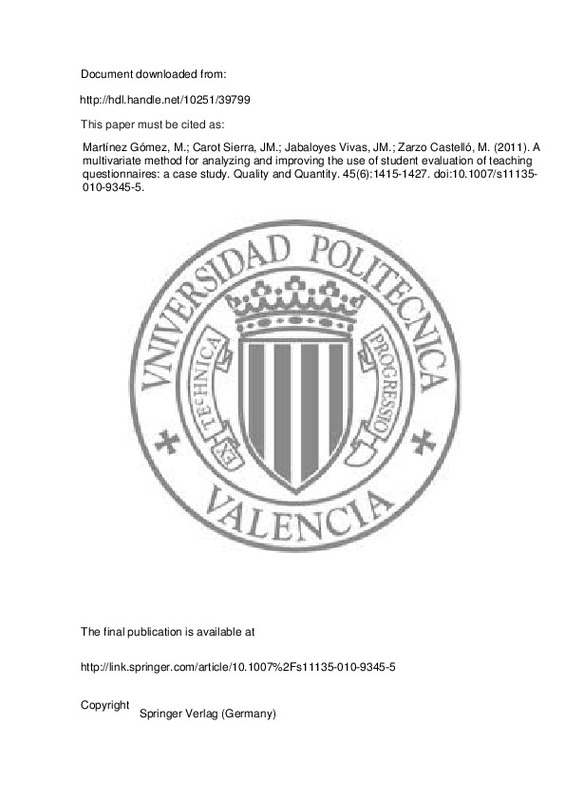Batista, J.M., Coenders, G. (eds): Modelos de Ecuaciones Estructurales. Cuadernos de estadística, 6. La Muralla, Madrid (2000)
Batista J.M., Coenders G., Alonso J.: Análisis Factorial Confirmatorio. Su utilidad en validación de cuestionarios relacionados con la salud. Med. Clin. (Barc.) 122(1), 21–27 (2004)
Bentler P.M.: Comparative fit indexes in structural models. Psychol. Bull. 107(2), 238–246 (1990)
[+]
Batista, J.M., Coenders, G. (eds): Modelos de Ecuaciones Estructurales. Cuadernos de estadística, 6. La Muralla, Madrid (2000)
Batista J.M., Coenders G., Alonso J.: Análisis Factorial Confirmatorio. Su utilidad en validación de cuestionarios relacionados con la salud. Med. Clin. (Barc.) 122(1), 21–27 (2004)
Bentler P.M.: Comparative fit indexes in structural models. Psychol. Bull. 107(2), 238–246 (1990)
Bentler P.M., Bonett D.G.: Significance tests and goodness of fit in the analysis of covariance structures. Psychol. Bull. 88, 588–606 (1980)
Berk R.A.: Survey of 12 strategies to measure teaching effectiveness. Int. J. Teach. Learn. High. Educ. 17, 48–62 (2005)
Bollen, K.A. (eds): Structural Equations with Latent Variables. Wiley, New York (1989)
Bollen, K.A., Long, J.S. (eds): Testing Structural Equation Models. Sage, Newbury Park (1993)
Brown M.W., Cudeck R.: Alternative ways of assessing model fit. In: Bollen, K.A., Long, J.S. (eds) Testing Structural Equation Models, pp. 136–162. Sage, Newbury Park (1993)
Cajide J.: Análisis factorial confirmatorio de las características de calidad docente universitaria (solución LISREL). Bordón 46(4), 389–405 (1994)
Campbell D.T., Fiske D.W.: Convergent and discriminant validation by the multitrait–multimethod matrix. Psychol. Bull. 56(2), 81–105 (1959)
Cashin W.E.: Concerns about using student ratings in community colleges. N. Dir. Community Coll. 11(1), 57–65 (1983)
Chiu, T., Fang, D., Chen, J., Wang, Y., Jeris, C.: A robust and scalable clustering algorithm for mixed type attributes in large database environment. In: Proceedings of Seventh ACM SIGKDD, International Conference on Knowledge Discovery and Data Mining, San Francisco, 2001
Feldman K.A.: The significance of circumstances for college student’s ratings of their teachers and courses. Res. High. Educ. 10, 149–172 (1979)
Göb R., McCollin C., Fernanda Ramalhoto M.: Ordinal methodology in the analysis of likert scales. Qual. Quant. 41, 601–626 (2007)
González Such, J.: Estudio de un Instrumento para la Evaluación del Profesorado Universitario. Thesis, Universitat de València, Valencia (1997)
Gursoy D., Umbreit W.T.: Exploring student’s evaluations of teaching effectiveness: what factors are important? J. Hosp. Tour. Res. 29(1), 91–109 (2005)
Hair, J.F., Anderson, R.E., Tatham, R.L., Black, W.C. (eds): Multivariate Data Analysis. Prentice Hall International, New York (1995)
Hu L., Bentler P.M.: Cut off criteria for fit indexes in covariance. Structure analysis: conventional criteria versus new alternatives. Struct. Equ. Model. 6(1), 1–55 (1999)
Jackson D., Teal C.R., Raines J.S., Nansel T.R., Force R.C., Burdsal C.A.: The dimensions of students’ perceptions of teaching effectiveness. Educ. Psychol. Meas. 59(4), 580–596 (1999)
Jöreskog K.G.: Testing structural equation models. In: Bollen, K.A., Long, J.S. (eds) Testing Structural Equation Models, pp. 294–316. Sage, Newbury Park (1993)
Jöreskog, K.G., Sörbom, D. (eds): LISREl V. Analysis of Linear Structural Relations by the Method of Maximum Likelihood. SPSS Publications, Chicago (1981)
Jöreskog, K.G., Sörbom, D. (eds): LISREL VI. Analysis of Linear Structural Relationships by Maximum Likelihood, Instrumental Variable, and Least Squares Methods. Scientific Software, Moresville (1986)
Kass G.V.: An exploratory technique for investigating large quantities of categorical data. Appl. Stat. 29(2), 119–127 (1980)
Lalla M., Facchinetti G., Maestroleo G.: Ordinal scales and fuzzy set systems to measure agreement: an application to the evaluation of teaching activity. Qual. Quant. 38, 577–601 (2004)
Marsh H.W.: Validity of students’ evaluations of college teaching: a multitrait multimethod analysis. J. Educ. Psychol. 74(2), 219–237 (1982)
Marsh H.W.: Students’ evaluations of university teaching: dimensionality, reliability, validity, potential biases, and utility. J. Educ. Psychol. 76(5), 707–754 (1984)
Marsh H.W.: Students’ evaluations of university teaching: research, findings, methodological issues and directions for future research. J. Educ. Res. 11(3), 253–388 (1987)
Marsh H.W.: Weighting for the right criteria in the Instructional Development and Effectiveness Assessment (IDEA) system: global and specific ratings of teaching effectiveness and their relation to course objectives. J. Educ. Psychol. 86, 631–648 (1994)
Marsh H.W., Hattie J.: The relation between research productivity and teaching effectiveness. J. High. Educ. 73, 603–641 (2002)
Mulaik S.A., James L.R., Van Alstine J., Bennett N., Lind S., Stilwell C.D.: Evaluation of goodness-of-fit indices for structural equation models. Psychol. Bull. 105(3), 430–445 (1989)
Rodríguez Sabiote, C., Gutiérrez Pérez, J.: Debilidades de la evaluación de la calidad en la universidad española. Causas, consecuencias y propuestas de mejora. Revista Electron. de Investig. Educ. 5(1) (2003). http://redie.ens.uabc.mx/vol5no1/contenido-sabiote.html . Retrieved 20 April 2005
Ting K.F.: A multilevel perspective on student ratings of instruction: lessons from the Chinese experience. Res. High. Educ. 41, 637–661 (2000)
Toland M.D., De Ayala R.J.: A multilevel factor analysis of student’s evaluations of teaching. Educ. Psychol. Meas. 65(2), 272–296 (2005)
[-]







![[Cerrado]](/themes/UPV/images/candado.png)


